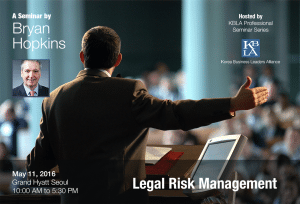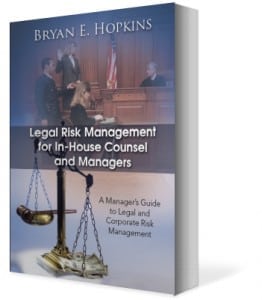Use KRIs To Create An Early Warning System
During the lazy days of Summer, companies or organizations tend to slow down. People go on vacation, customers or vendors go into Summer mode, organizations think less about risk management and more about company picnics or other fun events. People start thinking more about vacations and less about reality. When companies least expect things to go wrong they sometimes do. Not only do minor things go wrong but major crises tends to pop up, threatening the existence of the corporation itself! Companies are not only blindsighted when a crisis happens but sometimes they are completely unprepared.
A crisis is defined as a major unpredictable event that has potentially negative or catastrophic results. In today's business climate, where the culture of attack looms over any corporation that is unfortunate enough to receive bad publicity, companies cannot afford to conduct business without a proper crisis management plan in effect. Remember, unlike twenty years ago, a company can no longer handle a crisis by issuing a simple PR statement or marketing statement. A full fledged crisis management operation is usually required.
When a crisis happens people are often caught off guard. Some don’t even prepare for crisis or are blissfully unaware of the crisis lurking outside. And in the case of cross-border crisis, they are of course harder to manage than pure domestic ones. As international commerce and business adds an additional layer of complexity to any crisis situation, cultural and communication issues become front and center to any crisis management plan.
Therefore, when considering a crisis management plan, it helps to be proactive. It helps to identify potential crisis scenarios and prepare for the worst by running simulations. How will the company handle major crisis such as injury or death caused by its products? Or how will the company handle a media crisis resulting from the theft of its IP or customer data? Sometimes, however, it may be harder to identify areas of potential crisis. When that happens, I recommend that a company seriously considers developing effective, high-quality key risk indicators ( KRIs) that can provide metrics on risk exposure and early warning indicators.
KRIs , if developed properly can be used as an early warning system that may prevent crisis before they happen or at least warn the company in time of a potential crisis. That way, a company may be able to take proactive steps prior to a crisis to contain it or even prevent it. Examples of KRIs includes:
Once you have obtained these reports ( note they are data intensive) you have the beginning of KRIs and a good early warning system. Create a dashboard on your computer tailored to providing you with a picture of potential risks that could result in crisis. The dashboard can provide an excellent early warning system as to certain events that may result in a potential crisis. Remember, some crisis can be avoided if proper steps are taken before an incident evolves into a mega-crisis.
 Korea’s Anti-Corruption and Civil Rights Commission ( ACRC) recently published its annual report setting forth its major accomplishments for 2015. Though the ACRC was established in 2008, it has recently become very proactive in its measures to fight corruption in Korea. (more…)
Korea’s Anti-Corruption and Civil Rights Commission ( ACRC) recently published its annual report setting forth its major accomplishments for 2015. Though the ACRC was established in 2008, it has recently become very proactive in its measures to fight corruption in Korea. (more…)
 Last week I had the privilege of co-hosting the KBLA’s first seminar on Legal and Operational Risk Management. The primary focus was on legal risk management (LRM) and how risk management techniques can be used by in house counsel and managers to proactively address legal risks within a corporation. (more…)
Last week I had the privilege of co-hosting the KBLA’s first seminar on Legal and Operational Risk Management. The primary focus was on legal risk management (LRM) and how risk management techniques can be used by in house counsel and managers to proactively address legal risks within a corporation. (more…)
 For those of you who engage in business, everyone knows that properly managing risk plays an important part in the success of a company. However, though some companies may acknowledge the benefits of risk management , many don't consider legal risk management (LRM) processes when trying to mitigate or control and manage litigation risk issues, government investigations as well as legal liability. The benefits of ERM managment is never fully realized, leaving the company exposed to the tremendous costs associated with legal and corporate liability.
For those of you who engage in business, everyone knows that properly managing risk plays an important part in the success of a company. However, though some companies may acknowledge the benefits of risk management , many don't consider legal risk management (LRM) processes when trying to mitigate or control and manage litigation risk issues, government investigations as well as legal liability. The benefits of ERM managment is never fully realized, leaving the company exposed to the tremendous costs associated with legal and corporate liability. According to a recent survey of global CEOs, the top ten risks facing companies doing business around the world includes political risks, employment risks and even climate change risks. In fact, the top ten or even twenty risks do not include cyber security risks, IP related risks nor even credit control risks. If however, you look at the major scandals and threats facing companies in the last few years you will notice that cyber security, IP and credit related risks are actually front and center. (more…)
According to a recent survey of global CEOs, the top ten risks facing companies doing business around the world includes political risks, employment risks and even climate change risks. In fact, the top ten or even twenty risks do not include cyber security risks, IP related risks nor even credit control risks. If however, you look at the major scandals and threats facing companies in the last few years you will notice that cyber security, IP and credit related risks are actually front and center. (more…)
 Product liability risk is one of the most serious issues facing manufacturers today. Failure to mitigate or transfer product liability risk can result in massive law suits (including class actions), investigations, recalls and fines. Companies that fail to consider product liability risk when manufacturing products may be forced to close their doors if they fail to address the seriousness of product liability litigation, especially in the US. (more…)
Product liability risk is one of the most serious issues facing manufacturers today. Failure to mitigate or transfer product liability risk can result in massive law suits (including class actions), investigations, recalls and fines. Companies that fail to consider product liability risk when manufacturing products may be forced to close their doors if they fail to address the seriousness of product liability litigation, especially in the US. (more…)